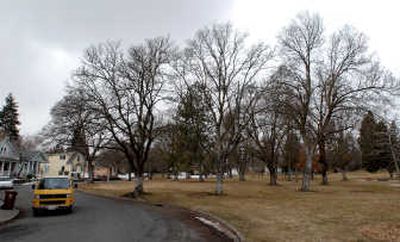Landmarks: Stadacona Circle became part of Grant Park in 1960s

From the Reader’s Mailbag: “I’ve always been curious about the predecessor to Grant Park. The story I’ve heard is that it was originally named Statacona Park. … Do you know the origin of the name or any other information on the park’s history?” – Cindy Fine
Back around 1900, Stadacona Circle (also Stadacona Park on some maps) was a 1.3-acre oval area on 11th Avenue between Ivory and Arthur streets. It was two blocks south of the original Grant Playground, which was located along Ivory Street between Ninth and 10th avenues.
In the “Report of the Board of Park Commissioners, 1891-1913,” it was noted that Stadacona Circle – “a nice little spot nicely planted with trees and shrubbery, making a small breathing spot for the neighborhood” – was donated to the city of Spokane by the Citizens’ National Bank and F.B. Grinnell.
At the time, according to the same report, the 2.97-acre Grant Playground was termed the city’s most complete, with improvements including grading and paving, play apparatus, tennis courts, a restroom and weather shelter.
Fast forward to the 1960s. That was when it was decided to enlarge Grant because of the loss of a significant piece of the nearby Liberty Park due to freeway construction, according to Taylor Bressler, division manager in charge of park planning for the city (and resident parks historian). Thus, Stadacona was joined to Grant, with the entire remodeling project expanding Grant as a neighborhood park to its present 13.6 acres.
Going west on 11th Avenue from Perry Street, the original Stadacona property appears as a southerly bulge in the park between Ivory and Arthur streets. There are still stately trees in place, but Stadacona as a distinct entity is now integrated into the larger park.
Perhaps more interesting still is the name Stadacona, which is the name of a 16th century St. Lawrence Iroquoian village near where Quebec City now stands, a place where French navigator Jacques Cartier moored his vessels in 1534.
There are many sites in Spokane that bear Native American names (like Spokane itself and others such as Manito Park). But the name Stadacona goes back to the naming of Canada itself.
“Canada” is derived from the Iroquoian word “kanata,” meaning village. It first appears in Cartier’s narratives describing the Stadacona community, so when he wrote of kanata, he was referring to Stadacona. Eventually, kanata was expanded from this original place name usage to refer to the lands north of the St. Lawrence River – and eventually becoming Canada, the world’s second-largest country (at 4 million square miles).
That’s quite a big hunk of namesake history for a tiny little circle of land in Spokane.